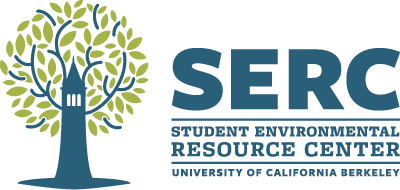UC Berkeley Waste Streams
UC Berkeley Waste Streams: Where does the waste go? Who does it affect? Why do our waste streams matter?
All of the waste generated on the UC Berkeley campus goes to facilities placed on stolen indigenous land, and keep in mind our campus is located on stolen indigenous land as well. Campus recycling goes to the Berkeley Recycling Center in Berkeley and Oakland’s Civicorp Material Recovery Facility, while our hazardous waste gets transported to either the Richmond Field Station in Berkeley, or to the CEAR Processing Facility in Mather, near Sacramento.¹ ² Waste managed in other parts of Berkeley or Oakland takes advantage of Ohlone, Muwekma, or Chochenyo land, as does our campus, while waste transported to Sacramento utilizes Miwok and Waali land. In addition to our e-waste or hazardous waste, our landfill and compost also gets processed on stolen indigenous land. Our compost goes to the City of Berkeley Transfer Station and to West Contra Costa Landfill in Richmond, while our landfill waste goes to Golden Bear Transfer Station in Richmond or the Republic Services Keller Canyon Landfill in Pittsburg.³ The waste processing facilities in Berkeley and Richmond take advantage of Ohlone, Muwekma, and Chochenyo land, while the Republic Services Keller Canyon Landfill in Pittsburg takes advantage of Me-Wuk, or Bay Miwok land.


It’s critical to remember that UC Berkeley does not pay the indigenous communities for the use of their land, and the entire campus community benefits from their losses. The Chochenyo, Ohlone, and Bay Miwok tribes are especially impacted by this history of displacement.⁴ There is an ongoing effort led by the indigiedous community to return this land back to its original owners. If you’re interested in supporting this rematriation, please consider paying the Shuumi Land Tax, which supports the women-led Sogorea Te’ Land Trust, who lead this cause. The website can be found at www.sogoreatelandtrust.com.


In addition to using others’ land, the exported waste harms the citizens of the cities the campus community exports its waste to. These cities, such as Richmond, Pittsburg, Mather, and Union City, include a much higher percentage of minority residents than UC Berkeley, specifically Hispanic/Latinx, Native American, Asian, and Black communities.⁵ ⁶ The percentage of Hispanic/Latinx people in Richmond and Pittsburg in particular is about twice as much as UC Berkeley’s. ⁷ ⁸ While the town of Mather has a higher percentage of White population compared to UC Berkeley, there is a larger percentage of Native American, Black, and Two or more race people in Mather than UC Berkeley. Similarly, Union City has a larger percentage of Asian, Hispanic/Latinx, Black, and Two or more race people than UC Berkeley. ⁹ ¹⁰
Comparing the demographics between UC Berkeley and the cities that manage our waste, it’s clear the management of our waste disproportionately exposes Latinx and Black communities to the potentially hazardous health effects that accompany waste handling. Pushing our waste onto these communities perpetuates the cycle of putting Latinx and Black communities at greater risk for negative health effects associated with waste handling.
Landfills, garbage incinerators, and industrial facilities are incredibly harmful to the environment they are placed in and to the residents of these communities they are placed in. They can contaminate and worsen air & water quality, smell awful, and expose people to adverse health effects.¹¹ Worsened air quality can lead to asthma and other respiratory illness in nearby residents, as well as eye, nose, and throat irritation, and weakness of the body from inhaling particulate matter, acidic gases, and toxics.
UC Berkeley’s waste management systems disproportionately affect communities of color, specifically Black and Latinx communities. To address this issue, Berkeley must be held accountable for its waste production, and prioritize waste reduction as a whole. To take individual action as environmental justice advocates, we can examine the products we consume to ensure they’re made in facilities with safe working conditions and out of ethically sourced materials. We can also reduce our plastic usage, and properly sort our waste to ensure it is not all landfilled. At the same time, advocacy for larger systemic change must also happen. Action must be taken at each level to create a greater difference in the Berkeley community, in the state, and in this nation.
Research & Writing by Zero Waste Membership Educational Module Team: Michelle Hernandez, Candace Wong, Megan Hur, Jakob Evans, and Alyssa Ha. A special thanks to the Zero Waste Coalition Chair, Julia Sherman
Sources:
¹ Berkeley Property Management: Disposal
³ “Cal Zero Waste FAQs: Operational Questions.” UC Berkeley Facilities Service.
⁴ “Native Land,” Native Land Digital.
⁵ “Diversity Data Dashboard,” UC Berkeley Diversity.
⁶ “UC Berkeley Demographics,” College Factual.
⁷ “Richmond, CA ACS Demographics and Housing Estimates,” United States Census Bureau.
⁸ “Pittsburg, CA ACS Demographics and Housing Estimates,” United States Census Bureau.
⁹ “Mather, CA ACS Demographics and Housing Estimates,” United States Census Bureau.
¹⁰ “Union City, CA ACS Demographics and Housing Estimates,” United States Census Bureau.
¹¹ Panne, Valerie Vande. “Smells like Environmental Racism,” In These Times. Oct. 25, 2017.


